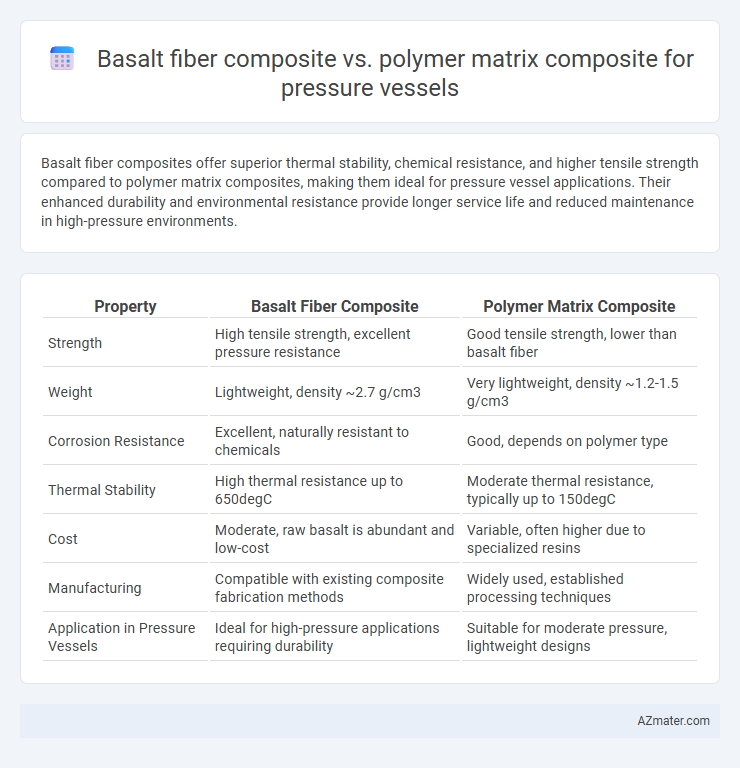Basalt fiber composites offer superior thermal stability, chemical resistance, and higher tensile strength compared to polymer matrix composites, making them ideal for pressure vessel applications. Their enhanced durability and environmental resistance provide longer service life and reduced maintenance in high-pressure environments.
Table of Comparison
| Property | Basalt Fiber Composite | Polymer Matrix Composite |
|---|---|---|
| Strength | High tensile strength, excellent pressure resistance | Good tensile strength, lower than basalt fiber |
| Weight | Lightweight, density ~2.7 g/cm3 | Very lightweight, density ~1.2-1.5 g/cm3 |
| Corrosion Resistance | Excellent, naturally resistant to chemicals | Good, depends on polymer type |
| Thermal Stability | High thermal resistance up to 650degC | Moderate thermal resistance, typically up to 150degC |
| Cost | Moderate, raw basalt is abundant and low-cost | Variable, often higher due to specialized resins |
| Manufacturing | Compatible with existing composite fabrication methods | Widely used, established processing techniques |
| Application in Pressure Vessels | Ideal for high-pressure applications requiring durability | Suitable for moderate pressure, lightweight designs |
Introduction to Pressure Vessel Materials
Pressure vessel materials must withstand high internal pressures while maintaining structural integrity and safety. Basalt fiber composites offer superior thermal resistance, corrosion resistance, and mechanical strength compared to traditional polymer matrix composites commonly used in pressure vessels. Polymer matrix composites provide flexibility and lower weight but may lack the enhanced durability and pressure performance exhibited by basalt fiber composites in demanding industrial applications.
Overview of Basalt Fiber Composites
Basalt fiber composites are manufactured from natural volcanic rock, offering high tensile strength, excellent corrosion resistance, and superior thermal stability compared to traditional polymer matrix composites commonly used in pressure vessels. Their inherent durability and non-toxic nature make basalt fibers an eco-friendly alternative, enhancing structural performance under high pressure and temperature conditions. This combination of mechanical robustness and sustainability positions basalt fiber composites as a compelling choice for advanced pressure vessel applications in aerospace, automotive, and industrial sectors.
Overview of Polymer Matrix Composites
Polymer matrix composites (PMCs) consist of a polymer resin reinforced with fibers such as glass, carbon, or aramid, offering high strength-to-weight ratios essential for pressure vessel applications. These composites exhibit excellent corrosion resistance and fatigue performance, making them suitable for storing gases and liquids under high pressure. Key advantages include design flexibility, ease of manufacturing via techniques like filament winding, and cost-effectiveness compared to more specialized materials like basalt fiber composites.
Mechanical Properties Comparison
Basalt fiber composites exhibit higher tensile strength and improved impact resistance compared to conventional polymer matrix composites, making them suitable for pressure vessels requiring enhanced durability. The modulus of elasticity in basalt fiber composites surpasses that of typical polymer composites, providing better stiffness under high-pressure conditions. Basalt fibers also offer superior thermal stability, contributing to the overall mechanical performance and longevity of pressure vessels in demanding environments.
Chemical Resistance and Durability
Basalt fiber composites exhibit superior chemical resistance compared to polymer matrix composites, offering enhanced protection against acids, alkalies, and solvents commonly encountered in pressure vessel environments. Their inherent basalt mineral composition provides excellent durability under extreme thermal and corrosive conditions, extending vessel lifespan and reducing maintenance needs. Polymer matrix composites, while lightweight and versatile, often require additional coatings or treatments to match the chemical resistance and long-term durability of basalt fiber composites in aggressive chemical applications.
Weight and Density Considerations
Basalt fiber composites exhibit a density of approximately 2.7-2.8 g/cm3, offering a balanced weight-to-strength ratio ideal for pressure vessels requiring moderate weight reduction. Polymer matrix composites typically have lower densities around 1.2-1.6 g/cm3, enabling significant weight savings but potentially sacrificing stiffness and thermal resistance. The choice between basalt fiber and polymer matrix composites hinges on optimizing vessel weight while maintaining structural integrity under high-pressure conditions.
Thermal Stability and Performance
Basalt fiber composites exhibit superior thermal stability compared to polymer matrix composites, maintaining mechanical integrity at temperatures up to 600degC, while traditional polymer matrices typically degrade above 150-250degC. The intrinsic thermal resistance of basalt fibers enables pressure vessels to endure high-temperature environments without significant loss of performance or structural deformation. This enhanced thermal performance makes basalt fiber composites ideal for pressure vessels used in aerospace, energy, and industrial applications requiring reliable operation under extreme thermal conditions.
Cost Analysis and Availability
Basalt fiber composites offer a cost-effective alternative to polymer matrix composites for pressure vessels due to lower raw material and manufacturing costs, while maintaining comparable mechanical properties. The natural abundance of basalt ensures high availability and stable supply chains compared to some synthetic fibers used in polymer matrix composites, which can suffer from price volatility. Basalt fiber composites also provide improved environmental sustainability, potentially reducing lifecycle costs associated with disposal and recycling.
Manufacturing and Fabrication Methods
Basalt fiber composites for pressure vessels offer enhanced thermal stability and corrosion resistance compared to polymer matrix composites, with manufacturing processes such as filament winding and resin transfer molding tailored to basalt's higher stiffness and moisture resistance. Polymer matrix composites employ versatile fabrication techniques like autoclave curing and vacuum bagging, allowing precise control over resin flow and curing cycles for optimized weight and strength performance. Both materials require specialized surface treatments and curing parameters to ensure strong interfacial bonding and durability under high-pressure conditions.
Application Suitability and Industry Trends
Basalt fiber composites offer superior thermal stability and corrosion resistance, making them highly suitable for pressure vessels in harsh industrial environments such as chemical processing and oil & gas. Polymer matrix composites, favored for their lightweight properties and ease of manufacturing, dominate applications in aerospace and automotive pressure vessels where weight reduction is critical. Industry trends indicate growing adoption of basalt fiber composites due to sustainability and enhanced mechanical performance, while polymer matrix composites continue evolving with advanced resin systems to meet stringent safety standards.

Infographic: Basalt fiber composite vs Polymer matrix composite for Pressure vessel
 azmater.com
azmater.com